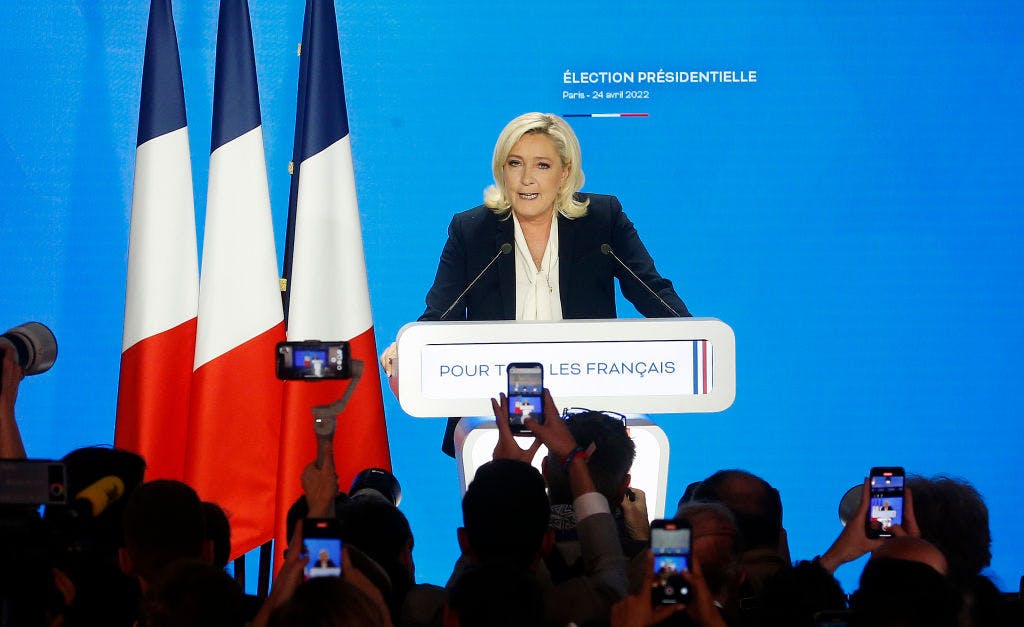New French Ban on Islamic Garb Seen as Thinly Veiled Attempt by Macron To Steal Le Pen’s Thunder
The move comes as France’s interior minister tells a French newspaper it is ‘quite probable’ Marine Le Pen will win the next presidency.

When is a crackdown on attire often associated with Islamic religious extremism not just about choice of wardrobe? In France today, political one-upmanship is very much in fashion, and the hot new trend for fall — especially if your designer label is Macron — is giving an elbow to your chief rival on the right, Marine Le Pen, the former and likely future presidential candidate.
That is the not-so-hidden context of the decision by President Macron’s education minister, Gabriel Attal, to interdict the wearing of Islamic abaya dresses, the sartorial choice of some Muslim women, in French schools. Wearing such garments, which typically cover the entire body except the hands, feet, and (sometimes) head, violate French laws on laïcité, the strong French tradition of secularism in education.
Mr. Attal told the French broadcaster TF1 that henceforth, “It will no longer be possible to wear an abaya at school,” adding that “clear rules at the national level” will be given ahead of la rentrée, the post-summer return to classrooms that starts on September 4.
The minister defended his decision in stubborn language that nevertheless spoke to the Cartesian logic that guides much political thinking in France regardless of party affiliation. “Secularism means the freedom to emancipate oneself through school,” he explained. “You enter a classroom, you must not be able to identify the religion of the students by looking at them.”
Mr. Attal described the Islamic abaya as “a religious gesture, aimed at testing the resistance of the republic toward the secular sanctuary that school must constitute.”
The new ban did not come out of le bleu. In 2004, the French parliament passed a law that forbade “the wearing of signs or outfits by which students ostensibly show a religious affiliation” in schools. In what was seen as a bid by the center-right government of President Chirac to deflect criticism that the law was singling out Muslims, the wearing of large Christian crosses and Jewish kippas as well as Islamic headscarves was proscribed.
As of now, the controversy created by the passage of the 2004 law appears to be greater than that generated by the new ban, though it is difficult to predict what will happen when classes resume next week. In the run-up to the announcement, students wearing abayas in schools had in some cases been starting to cause friction between parents and teachers. That led to increased calls for a ban from the right side of the political spectrum.
The chairman of the opposition right-wing Republicans party, Eric Ciotto, stated, “We called for the ban on abayas in our schools several times.”
Furthermore, the head of a prominent French teacher’s union, Bruno Bobkiewicz, said that before “the instructions were not clear, now they are and we welcome it.”
An opposition party on the left, La France Insoumise, or France Unbowed, was less enthused. One of the party’s deputies, Clémentine Autain, said that the ban reflected the Macron administration’s “obsessive rejection of Muslims” and deemed it unconstitutional.
According to the French national statistics bureau, Insee, Muslims make up at least 10 percent of France’s population. A prior report from Insee stated, “Immigrants coming from traditionally Muslim countries are more engaged in religion.”
Immigrants, typically but not always of Muslim background, figure prominently in France’s episodic bouts of civil unrest. The most recent was in late June and July, when violent clashes and looting followed the police shooting of a teenager outside Paris. Those riots caused millions of dollars’ worth of property damage and provided ample fodder for criticism of Mr. Macron’s laissez-faire approach from Ms. Le Pen of the National Rally, the right-leaning successor party to the far-right National Front founded by her outspoken father, Jean-Marie Le Pen.
As the Sun has reported, in the wake of those clashes the National Rally surged in popularity, and according to one poll a majority of French voters would rather see Ms. Le Pen in the Palais Élysée today than Mr. Macron.
While Mr. Macron is safely in his second term and the next presidential election is not until 2027, his neo-liberal Renaissance party lacks a parliamentary majority. The competition with Ms. Le Pen is, in a sense, already in progress. That has contributed to a growing sense that in promulgating the abaya ban at the precise moment that the French return from their annual summer holidays and start re-engaging with la vie politique, Mr. Macron is not-so-subtly trying to co-opt Ms. Le Pen’s base to feather his own thinning electoral nest.
Ms. Le Pen once described the hijab as “a uniform imposed by Islamists,” so it is possible that she would be in a rare alignment with Mr. Macron on the abaya ban. What is certain, though, is that her star is rising.
That is why last week France’s young interior minister, Gerald Darmanin, told a French newspaper that it was “quite probable” Ms. Le Pen would clinch the presidency. On Sunday at the northern town of Tourcoing, he told a crowd, “We are here to say that there is a problem. Obviously, we cannot give Marine Le Pen an inexorable path to power.”
“People are asking for much more security, they are asking for better control of immigration, for secularism to be reaffirmed,” the 40-year-old Mr. Darmanin said.

